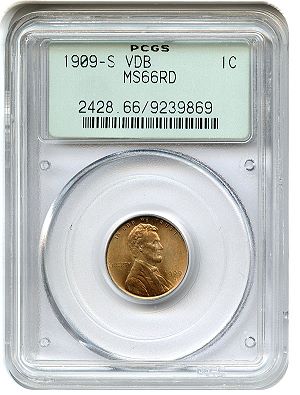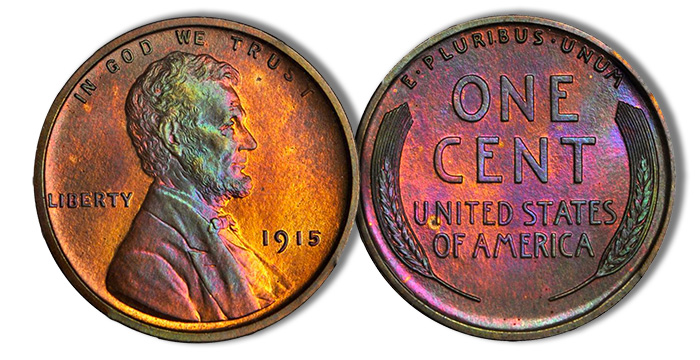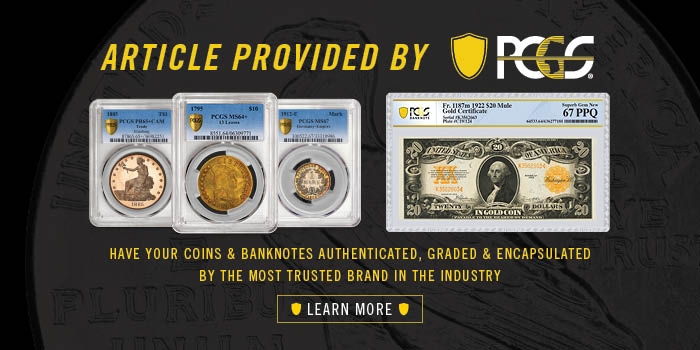
By Joshua McMorrow-Hernandez for PCGS ……
Lincoln cent collectors new and seasoned alike know the three ubiquitous letters of their specialty.
These are the letters “VDB”, which boldly appear on the reverse of the scarce 1909 VDB and rare 1909-S VDB Lincoln cents and the obverse of all Lincoln cents made since 1918.
For many, the “VDB” initials are an important if faceless feature on the Lincoln cent. But there is a face behind the “VDB”, and the man to whom those letters belong is Victor David Brenner, a celebrated medalist and sculptor who was born in Lithuania 1871 as Avigdor David Brenner and immigrated to the United States in 1890.
Settling in the New York City area, Brenner found success as a gem and seal engraver – trades that parlayed the sculpting talents he had learned from his father, an ornamental sculptor and engraver. The younger Brenner was also enamored with numismatics and in 1894 joined the American Numismatic and Archaeological Society, an organization for which he eventually served as a die-cutting instructor; in 1902, Brenner became a member of the American Numismatic Association (ANA).
 By the 1900s, Brenner was producing medallic dies for various private ventures and had become adept in the Janvier reducing lathe, a device used for accurately transferring designs on Galvano-sized plaster models down to the final die size. He had gained great respect for his artistry and die-making skills and was commissioned for various projects, including a rectangular 1903 Amerigo Vespucci medal that was particularly well received in the medal community.
By the 1900s, Brenner was producing medallic dies for various private ventures and had become adept in the Janvier reducing lathe, a device used for accurately transferring designs on Galvano-sized plaster models down to the final die size. He had gained great respect for his artistry and die-making skills and was commissioned for various projects, including a rectangular 1903 Amerigo Vespucci medal that was particularly well received in the medal community.
The project that helped seal Brenner’s legacy was a 1907 medal and plaque featuring a right-facing profile of Abraham Lincoln. Several hundred or more reproductions were quickly created. Nostalgia surrounding Lincoln, who was assassinated in 1865 in the waning days of the Civil War, was sweeping the nation as the centennial of his birth in 1809 was nearing.
Creating the Lincoln Cent
Brenner and President Theodore Roosevelt were discussing the Lincoln plaque, and this conversation led to the idea of placing Lincoln’s profile on a circulating coin. Meanwhile, Brenner was gaining acclaim in numismatic circles both for his work as a die engraver and medal artist and for having helped found the New York Numismatic Club in December 1908.
During this time, Brenner and Roosevelt continued their discussions of a Lincoln coin, leading to a January 1909 letter submitted by the Treasury Department to the editor of The Numismatist stating “President Roosevelt has given his consent to the placing of the head of Lincoln on one of the popular coins.” The letter went on to say that “Victor D. Brenner, New York sculptor, has submitted to the director some models of Lincoln busts, and these have been shown to the president. The Head of Lincoln will adorn one side of the coin and the customary coat of arms on the other.”
By March 1909, it was decided the denomination to receive the new Lincoln design would be the one-cent coin, which had carried the Indian Head motif since 1859. Models containing the right-facing bust of Lincoln, adapted from Brenner’s 1907 medal and plaque, were created for the obverse. Meanwhile, a variety of reverse designs was eventually pared down to one containing a pair of wheat stalks representing national prosperity.
The numismatic world became privy to the developments of the new Lincoln cent through published reports in The Numismatist, which, in the March 1909 issue, had announced the coming arrival of Brenner’s new Lincoln design and the July edition stated that 22,213,575 one-cent coins had been minted at the Philadelphia Mint in June, “believed all to be of the new type.”
The new Lincoln cent was released on August 2, 1909, to warm public reception. Lines formed around the block at the Treasury Building in Washington, D.C., the Philadelphia Mint, and at other places supplying the coin. The coin was a hit, being the first non-commemorative circulating coin struck with the bust of a former United States president, and posthumously one of the most popular at that. Enterprising young children who managed to purchase quantities of the coin sold them for three, five, even 25 cents each on the day of release.
Nevertheless, some of the early recipients of the Lincoln cent took exception with the prominence of Brenner’s “VDB” initials on the bottom of the reverse, between the two wheat ears.
The “VDB” Controversy
The relatively small “VDB” feature on the reverse had been negotiated down from the more prominent placement of Brenner’s full name on the obverse, as the artist had originally designed on early models. However, some dissatisfaction with the “VDB” initials, either from the public or internally at the United States Mint or United States Treasury, was related to the media. A New York Times story from August 5, 1909 says:
“Secretary of the Treasury [Franklin] MacVeagh has decided to stop the minting of the new Lincoln Cents. New dies will be prepared as soon as possible, substituting for the initials of the designer the single initial ‘B’ in an obscure part of the design. None of the cents issued so far will be called in, but the minting be stopped because a sufficient supply is on hand. The initials V.D.B. are those of the designer, V.D. Brenner of New York, and the single initial will be, it is considered, a sufficient recognition of his work. This decision created much surprise, as the Treasury Department announced yesterday that the new coins would be in circulation for the present at least, and that the use of the initials on them was in line with a custom that had prevailed for years. This prominence, however, awakened widespread criticism, and today’s action followed further consideration of the matter. Mr. MacVeagh said today that he did not know that the initials would appear in embossed form on the pennies, and that he was surprised when he saw them. It has been customary to allow designers to cut initials into the design somewhere, but they have usually been so small as to require a magnifying glass to discover them.”
As many numismatists know, one does not need a magnifying glass to see the “VDB” initials on the Lincoln cent. They are clearly evident at the base by the bottom center of the reverse rim. And the prominence of this feature has only helped secure the popularity of this type, which ultimately lasted only a couple weeks in production before the initials were pulled.
While plans were publicized to recognize Brenner on the coin with a simple and inconspicuous “B,” Assistant Secretary of the Treasury C.D. Norton saw a logistics issue with this, stating that while adding a “B” to the coin somewhere would be an easy process, removing the intaglio “VDB” inscription from the master hub could take at least two weeks. The most efficient solution would be to simply erase the “VDB” initials without inscribing a “B” elsewhere on the coin.

Maybe the move was efficiency at work, or perhaps heated internal politics were gaining the upper hand. This could be reasonably concluded as then-Chief Engraver Charles E. Barber, whose name is also represented as a single “B” on his coinage, did not want the public to think he had a hand in creating the Lincoln cent, a coin he personally disliked.
Brenner’s Legacy Secured
Brenner was understandably upset that his initials were removed, especially given that many other coins of the day had carried the initials of their respective designers – a point MacVeagh had himself illustrated in the August 5, 1909 New York Times article partly republished above. As Brenner wrote to The Numismatist on August 12, 1909:
“It is mighty hard for me to express my sentiments with reference to the initials on the cent. The name of the artist on a coin is essential for the student of history as it enables him to trace environments and conditions of the time said coin was produced. Much fume has been made about my initials as the means for an advertisement; such is not the case. The very talk the initials has brought out has done better for numismatics than it could do me personally. The cent not alone represents in part my art, but it represents the type of art of our period.”
Brenner would live to see his initials restored on the Lincoln cent in 1918, an act that happened only after MacVeagh was superseded by Secretary of the Treasury William McAdoo in 1913 and after Barber’s passing four years later in 1917. Numismatists could argue it was Brenner who came out ahead in the end. Not only did his “VDB” initials reemerge on the obverse instead of the reverse (the obverse being where the artist had originally wanted his name represented), but also his original 1909 VDB coins became among the most desirable collectibles in all of numismatics.
Today, the 1909 VDB Lincoln cent is among the most popular of the series, with the Philadelphia issue serving as a significant first-year and one-year-only type coin. Meanwhile, the 1909-S VDB Lincoln cent from the San Francisco Mint reigns as the series key. The 1909-S VDB Lincoln cent is the lowest-mintage regular-issue cent in the series, with only 484,000 having been struck. It’s one of the few numismatic rarities that even many non-collectors know about and actively seek in circulation – if to virtually no avail these days.
The Lincoln cent continues onward as the longest-issued major type in United States coinage. Furthermore, it is one of the most widely collected coins in the world, with people even from other nations collecting Brenner’s one-cent coin as a representative United States type.
Brenner died in 1924, never seeing his numismatic brainchild become the success that ultimately it has grown to be.






This is Dave Mowdy i want to thank you all very much. Now I have found some more early 1900s wheat penny some have doubled dye 1918 just wanted to find out if it maybe worth anything?
I actually have a 1909 VDB wheat penny.